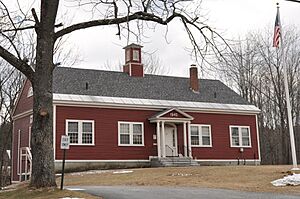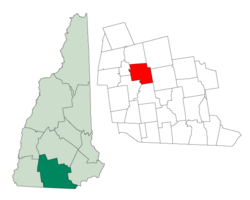Francestown, New Hampshire facts for kids
Quick facts for kids
Francestown, New Hampshire
|
|
|---|---|
|
Town
|
|

Town hall
|
|

Location in Hillsborough County, New Hampshire
|
|
| Country | United States |
| State | New Hampshire |
| County | Hillsborough |
| Incorporated | 1772 |
| Area | |
| • Total | 30.4 sq mi (78.7 km2) |
| • Land | 29.8 sq mi (77.2 km2) |
| • Water | 0.6 sq mi (1.5 km2) 1.85% |
| Elevation | 831 ft (253 m) |
| Population
(2020)
|
|
| • Total | 1,610 |
| • Density | 54/sq mi (20.9/km2) |
| Time zone | UTC-5 (Eastern) |
| • Summer (DST) | UTC-4 (Eastern) |
| ZIP code |
03043
|
| Area code(s) | 603 |
| FIPS code | 33-27140 |
| GNIS feature ID | 0873598 |
Francestown is a small town located in Hillsborough County, New Hampshire, in the United States. In 2020, about 1,610 people lived there. The main village of Francestown, which is in the center of the town, had a population of 201 people in 2020.
Contents
History of Francestown
Francestown became an official town in 1772. It was named after Frances Deering Wentworth. She was the wife of John Wentworth, who was the colonial governor at the time.
When the first count of people was done in 1790, Francestown had 928 residents. For a while, the town was on an important road called the Second New Hampshire Turnpike. This road was the only way to travel between Boston and Vermont. Francestown collected a small fee from coaches and wagons using the road.
From 1792 to 1912, a special type of rock called soapstone was dug up in Francestown. This soapstone was known for its high quality.
Geography of Francestown
Francestown covers an area of about 78.7 square kilometers (about 30.4 square miles). Most of this area is land, with a small part being water.
The highest point in Francestown is the top of Crotched Mountain. This mountain is about 630 meters (2,066 feet) above sea level. It is located on the western edge of the town.
All the water in Francestown flows into the Merrimack River. This happens through smaller streams that lead to the Piscataquog River. Two state roads, Route 47 and Route 136, pass through the town.
Population Changes in Francestown
| Historical population | |||
|---|---|---|---|
| Census | Pop. | %± | |
| 1790 | 982 | — | |
| 1800 | 1,355 | 38.0% | |
| 1810 | 1,451 | 7.1% | |
| 1820 | 1,479 | 1.9% | |
| 1830 | 1,540 | 4.1% | |
| 1840 | 1,308 | −15.1% | |
| 1850 | 1,114 | −14.8% | |
| 1860 | 1,082 | −2.9% | |
| 1870 | 932 | −13.9% | |
| 1880 | 937 | 0.5% | |
| 1890 | 837 | −10.7% | |
| 1900 | 693 | −17.2% | |
| 1910 | 602 | −13.1% | |
| 1920 | 385 | −36.0% | |
| 1930 | 363 | −5.7% | |
| 1940 | 342 | −5.8% | |
| 1950 | 405 | 18.4% | |
| 1960 | 495 | 22.2% | |
| 1970 | 525 | 6.1% | |
| 1980 | 830 | 58.1% | |
| 1990 | 1,217 | 46.6% | |
| 2000 | 1,480 | 21.6% | |
| 2010 | 1,562 | 5.5% | |
| 2020 | 1,610 | 3.1% | |
| U.S. Decennial Census | |||
The population of Francestown has changed a lot over the years. In 2000, there were 1,480 people living in the town. By 2020, the population had grown to 1,610 residents.
In 2020, the average income for a household in Francestown was about $102,721. Most people in Francestown who work are employed by private companies. Many others are self-employed or work for the government.
Famous People from Francestown
Many interesting people have come from Francestown:
- Samuel Bell (1770–1850) was the 14th governor of New Hampshire.
- James Wallace Black (1825–1896) was a well-known photographer.
- Titus Brown (1786–1849) served as a US congressman.
- Benjamin Pierce Cheney (1815–1895) was a successful businessman.
- Ellen Cheney Johnson (1829–1899) worked to improve prisons.
- Sylvester H. Roper (1823–1896) was an inventor. He invented the shotgun choke and was added to the Motorcycle Hall of Fame in 2002.
- Aaron Draper Shattuck (1832–1928) was a painter known for his White Mountain School artwork.
- Wallace Tripp (1940–2018) was a famous illustrator.
- Eri D. Woodbury (1837–1928) received the Medal of Honor for his brave actions during the Civil War.
- Levi Woodbury (1789–1851) was an associate justice of the Supreme Court of the United States. He was also the 15th governor of New Hampshire.
Important Buildings in Francestown
Francestown has several historic and important buildings:
- Francestown Meetinghouse
- Francestown Town Hall and Academy and Town Common Historic District
- Levi Woodbury Homestead
- George Holmes Bixby Memorial Library
Images for kids
See also
 In Spanish: Francestown (Nuevo Hampshire) para niños
In Spanish: Francestown (Nuevo Hampshire) para niños




